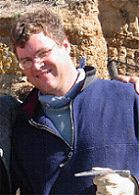 |
Dr. Kirk
Johnson, DMNS chair of the Department of Earth Sciences, curator of
paleontology
Education:
Ph.D. in geology and paleobotany (1989), Yale University; M.S. (1985),
University of Pennsylvania; M. Phil. (1987); and B.A. (1982), Amherst College
Motivation/Goals:
Joined the Museum in 1991. Best known for his research on fossil
plants, which is widely accepted as some of the most convincing support
for the theory that an asteroid impact caused the extinction of dinosaurs.
During his tenure at the Museum, he has been instrumental in the planning,
content and construction of the Museum's award-winning exhibition Prehistoric
Journey. He has co-authored two books, "Prehistoric Journey: A History
of Life on Earth" and "Ancient Denvers: Scenes from the past 300 million
years of the Colorado Front Range."
Project
Role(s): As DMNS chair of Earth Sciences and curator of paleontology,
Dr. Johnson oversees many paleontology projects. His recent research
focuses on the fossil plants of the Denver Basin, and he has supervised
excavations at more than 50 Denver area fossil sites, including the Castle
Rock Rainforest, Denver International Airport and Coors Field. He
has authored papers on the findings at Castle Rock which appeared in publications
such as the journal SCIENCE [1]. He's also
been actively involved in presenting the Castle Rock findings to the scientific
community at the Geological Society of America (GSA) [2]
and
other conferences.
Contact
Information: Denver Museum of Nature and Science, Department of Earth
and Space Sciences, 2001 Colorado Boulevard, Denver, CO 80205-5798, phone:
303-370-6448, e-mail: kjohnson@dmns.org
|
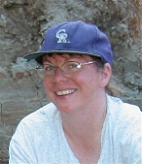 |
Beth Ellis,
DMNS, Castle Rock Project Supervisor
Education:Coming
Soon....
Motivation/Goals:
Began volunteering at the Denver Museum of Nature & Science in 1993
after completing the Museum's Certification Program in Paleontology. Working
as a microelectronics engineer by day, she fulfilled her lifelong passion
for research and fossils through field experiences with dinosaur bones,
early mammal bones, trilobites and fossil leaves.
Project
Role(s): Project supervisor of the Castle Rock team. Part of
the original Castle Rock excavation team in 1994, Beth curated and performed
the early analysis of the fossil collection. A recent trip to the Amazon
gave her a first-hand look at a modern rainforest floor and provided comparison
data for the Castle Rock fossils. Currently she leads the team of paleontologists
and volunteers excavating and analyzing additional quarries at the Castle
Rock site. She co-authored a paper that was published in the journal
SCIENCE [1] and presenting the team's findings
to the scientific community at the Geological Society of America (GSA)
[2].
|
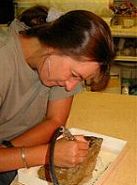 |
Michele
Reynolds, DMNS staff
Education:
Coming
Soon....
Motivation/Goals:
Became tired of her career in human resources. Completed the DMNS
paleontology certification program and volunteered at the museum for years
before joining the staff of the Earth Sciences Department.
Project
Role(s): Fossil excavation, cataloguing, morphotyping and research.
Contact
Information: mlreynolds@dmns.org
|
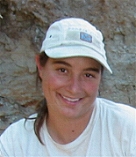 |
Regan E.
Dunn, DMNS staff
Education:
B.S. in biological sciences (1995) Colorado State University; M.S. in botany
(expected graduation: Dec 2002) University of Wyoming
Motivation/Goals:
Three and a half years ago, Regan joined the Denver Basin Project at DMNS
as a geologic intern working on the Kiowa Drilling Project. Since
that time, she has dedicated herself to the study of Paleocene floras from
the Hanna Basin in south-central Wyoming, and the coeval Castle Rock Rainforest.
Her primary research interests are biological evolution, biostratigraphy,
ecosystem reorganization following extinction events, evolution of tropical
rainforests, stratigraphy and sedimentology.
Project
Role(s): Stratigraphic/geological research, fossil excavation, and
research.
Contact
Information:
|
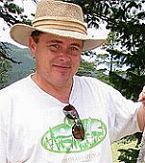 |
Steve Wagner,
DMNS
Volunteer
Education:
M.S. in systems management (1989), University of Southern California; B.S.
in computer science & mathematics (1985), Southwest Texas State University,
Certificate in information systems (1989) from USC, Certificate in paleontology
(in work) from Denver Museum of Nature & Science.
Motivation/Goals:
Steve has had a lifelong interest in fossils and began the DMNS paleontology
certification program in 2001. He inquired about volunteer efforts
in paleontology to explore his interests while on a "sabbatical from the
working world" where he runs Wagner Database Solutions, Inc., an Englewood
database consulting firm. He jumped at the opportunity to work on
the Castle Rock rainforest.
Project
Role(s): Fossil excavation; trimming & wrapping; digital imaging;
developer of this Castle Rock website.
Contact
Information: paleo-at-paleocurrents-dot-com
|
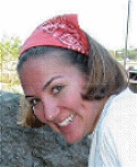 |
Susan Echt,
DMNS Intern Volunteer
Education:
Working on B.S. at Colorado College.
Motivation/Goals:
Susan is an intern at DMNS, while completing he education at Colorado College.
Project
Role(s): Fossil excavation; trimming & wrapping; cataloguing
Contact
Information: s_echt@coloradocollege.edu
|
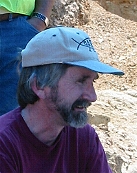 |
Steve Wallace,
paleontologist with CDOT (Colorado Department of Transportation)
Education:
B.S. in Geology (1975), College of William and Mary, Williamsburg, Virginia;
M.S. in Geological Sciences (1980), University of Colorado, Boulder.
Motivation/Goals:
There has been a full-time permanent, in-house paleontologist at the Colorado
Department of Transportation (CDOT) since 1979. Steve joined CDOT
as archaeological/paleontological survey supervisor in November of 1979
and has been the staff paleontologist since August of 1984. He is
a vertebrate paleontologist, and as a specialist in Eocene extinct odd-toed
ungulates and late Pleistocene ground squirrels, has no use for dinosaurs.
Through his work with CDOT and the Denver Museum of Nature and Science,
he has, against his better judgment, learned to love plant fossils.
Project
Role(s): CDOT paleontologist, discovered site in 1994, participates
in fossil digs, directs excavation with CDOT backhoes, liaison between
CDOT and DMNS.
Contact
Information: steven.wallace@dot.state.co.us
|
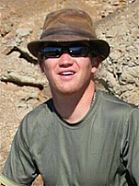 |
Rich Barclay,
DMNS staff
Education:
B.S. (1996), Western Washington University; M.S. University of Florida
Motivation/Goals:
Fossil plants are amazing treasures. Denver Basin fossil plants may play
a key role in understanding the dynamics of the K-T boundary extinction
for the interior of the United States. The Denver Basin sediments and their
entrapped fossils provide a unique window onto the landscape during this
exciting interval of massive extinction 65.5 million years ago. Rich's
ongoing research tries to uncover how the Denver Basin plant ecosystems
fared in this global biological catastrophe.
Project
Role(s): The Castle Rock rainforest is one of many fossil excavation
sites Rich has been involved in with the Denver Basin project. He
participates in fossil excavations and research.
Contact
Information: rbarclay@dmns.org
|
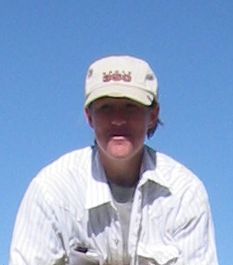 |
Nicole
Boyle, DMNS staff
Education:
Coming
Soon...
Motivation/Goals:
Coming
Soon...
Project
Role(s): Fossil excavation.
Contact
Information:
|
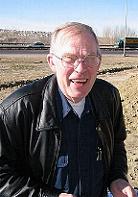 |
Jim Sundine,
DMNS volunteer
Education:
Coming
Soon...
Motivation/Goals:
Jim has had a long-time interest in fossils. His daughter was one
of the key designers of the Prehistoric Journey exhibit at DMNS.
He completed the Paleontology Certification Program at DMNS and is a very
active
volunteer.
Project
Role(s): Wrapping fossils at the quarries, unwrapping and storing specimens
in the DMNS collections.
Contact
Information: Coming Soon...
|









